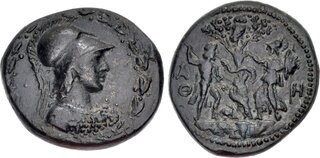| Classical Numismatic Group > Triton XXVII | Auction date: 9 January 2024 |
| Lot number: 460 Price realized: 4,000 USD (Approx. 3,664 EUR) Note: Prices do not include buyer's fees. | Show similar lots on CoinArchives Find similar lots in upcoming auctions on |
| Lot description: ATTICA, Athens. Circa AD 120-140/50. Æ (30mm, 16.31 g, 9h). Helmeted bust of Athena right, wearing necklace and aegis; all within laurel wreath / AΘ H, The naming of Athens: Poseidon, on left, advancing right, brandishing trident; on left, Athena advancing left, raising right hand and holding spear and shield in left; between them, olive tree entwined by serpent, in the branches, owl facing right. Kroll 174; RPC IV.1 8191; Svoronos, Athenes 89.3 (same dies as illustration); BMC 710. Dark green patina with light earthen highlights, minor cleaning marks. Good VF. Well struck on a full flan and in an exceptional state of preservation. According to legend, the city of Athens had been built by the serpent-god Cecrops and named Cecropia. He ruled the prospering city but the Olympian gods became jealous as the city never paid tribute to them. Athena and Poseidon both desired to be the patron deity of the fledgling city and Zeus declared a contest, the people of the city gathered to watch the spectacle. Poseidon moved first and struck the top of the Acropolis with his trident, the earth shook and water poured from the hole like a geyser, this gift meant the citizens would never face drought. But they soon realized that the water was saltwater and became angry as the city had close proximity to the sea. Athena laughed and knelt a few feet away, she planted something in the ground. A few moments later an olive tree grew to full maturity; she demonstrated the fruit it bore could be used as food and oil, and the tree could be used as a source of lumber. The tree had multiple uses. Athena proved that she was the goddess of wisdom, thus, the city was named Athens and the temples of the Parthenon were erected in her honor. Poseidon, in anger, cursed the land to be arid and the lakes dried. There is an alternate story where Poseidon struck the rock and the first horse sprung forth, a scene that was depicted on the west pediment of the Parthenon. An olive tree still stands today at the spot of the battle, the current tree is believed to have been planted around WWII. Estimate: 750 USD |  |



